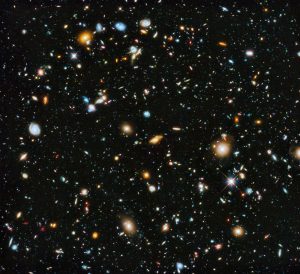
![]() On April 24, 1990, the Hubble Space Telescope was launched. After repairs in orbit in 1993, the telescope has gone on to reshape our perception of the cosmos with images of nearby planets, the birth of stars, and the farthest reaches of the universe.
On April 24, 1990, the Hubble Space Telescope was launched. After repairs in orbit in 1993, the telescope has gone on to reshape our perception of the cosmos with images of nearby planets, the birth of stars, and the farthest reaches of the universe.
The images associated with the Hubble’s voyage are not taken as standard photographs. They are computer-generated images that begin with incoming black and white data from multiple cameras that is then post-processed as a composited image. Colors are assigned to wavelengths of light that are invisible to the human eye.

In creating these images, astronomers balance the need to convey scientifically valid information and the larger public appeal of aesthetically enticing pictures of distant and even invisible phenomena. These images have found their way onto calendars and screen savers, posters and book covers, shaping our expectations for a new age of astronomical photographs.
Since its formation in 1997, the Hubble Heritage Project, a group of astronomers and image processors, has released a new image almost every month. They also provide do-it-yourself instructions for amateurs to do their own image processing from Hubble data. Their pictures have publicized Hubble’s findings to a broad public and provided popular support for the telescope.
This photograph shows the extreme past of the universe, a few 100 million years after the Big Bang. According to NASA’s website, the image was made with the addition of ultraviolet data to cover the entire range of wavelengths available to Hubble’s cameras. Ultraviolet data enables astronomers to study star formation between 5 and 10 billion light-years distant.[footnote]“Astronomy Picture of the Day,” June 5, 2014 https://apod.nasa.gov/apod/ap140605.html. Accessed February 16, 2017.[/footnote]
Professor Frank Winkler and Jonathan Kemp discuss the photograph: